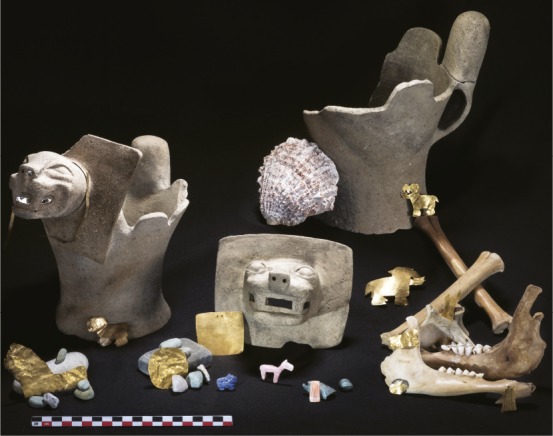Snapshot of asteroid-induced mass extinction in North Dakota
Left: Thin-section photomicrograph of shocked mineral from the Tanis Cretaceous–Paleogene boundary. Right: Micro-computed tomography of ejecta spherule, digitally dissected to reveal core of unaltered impact-melt glass.
The Chicxulub crater in Mexico’s Yucatan Peninsula bears witness to a cataclysmic asteroid impact in the Cretaceous Period that triggered a global mass extinction and heralded the end of the dinosaur age. The impact’s protracted effects on Earth’s environment and biota are extensively documented, but its immediate aftermath remains shrouded in mystery, partly due to a dearth of time-resolved deposits. Robert DePalma et al. (pp. 8190–8199) describe deposits at Tanis, a terrestrial site in North Dakota’s Hell Creek Formation teeming with clues to events that likely unfolded minutes-to-hours after impact. Inland-directed flow indicators and a mix of fossilized Cretaceous biota at Tanis hint at a sudden, rapid, and massive surge of water from an arm of the Western Interior Seaway that was triggered by seismic waves from Chicxulub. The surge, termed a seiche, was at least 10 m in runup height and deposited a fossil-rich bed at Tanis. Additionally, the presence of impact-induced debris that settled from the atmosphere or through the water column, including spheres ensnared in the gills of entombed fish, impact-melt glass preserved in amber, shocked minerals, and an iridium signature in the layer capping the deposit, together suggest that the surge and deposit occurred shortly after impact. Analysis of ballistic trajectories of impact-triggered debris suggests that debris showers reached Tanis within 15 minutes of impact, shortly after the seiche wave, and were mostly deposited within 2 hours. According to the authors, the evidence linking impact-triggered seismic activity and the onshore surge at Tanis offers an additional mechanism through which the asteroid may have rapidly set in motion a global mass extinction. — P.N.
Sustainability of seaduck harvesting

Male and female seaduck.
Seaducks (Somateria mollissima borealis) underwent population declines in the eastern Canadian arctic throughout the 20th century. However, sparse nest count records and a lack of standardized bird surveys before the 1950s have rendered population estimates challenging. To determine the historical causes of the decline, Kathryn Hargan et al. (pp. 8425–8430) analyzed biomarkers in bird feces preserved in pond sediment cores from 10 subartic seaduck colonies, thus reconstructing population changes throughout the 20th century. One island colony of seaducks faced no local hunting pressure; three colonies faced low-to-moderate hunting pressure; and six nesting islands experienced high hunting pressure. Changes in nitrogen isotopes and sterols in the sediment cores revealed a long-term decline in seaducks across colonies facing high hunting pressure in the early 20th century. The authors note that the latter finding reflects the nearby relocation of Inuit communities and the introduction of guns in West Greenland. In contrast, the colony located on the island with no local hunting exhibited stable nitrogen isotopes over approximately 200 years. The paleolimnological records suggest that hunting practices in 20th-century West Greenland and northern Canada adversely affected seaduck populations. According to the authors, current seabird monitoring practices should consider long-term population dynamics to reach informed conservation decisions. — T.G.
Daisy-chain gene drives for controlled ecological engineering

Mosquitoes are among the disease vectors in which gene drives have been tested in the lab. Image courtesy of iStock/Chansom Pantip.
Gene drives based on CRISPR-Cas9 can rapidly spread engineered traits through entire populations, offering a way to wipe out vector-borne diseases, agricultural pests, and invasive species. However, the risk of such drives spreading to unintended targets when deployed in the wild prevents field-testing, which is a prerequisite for regulatory approval and commercial application. Charleston Noble, John Min, et al. (pp. 8275–8282) expanded the concept of a split gene drive, in which different drive elements are physically separated for granular control of the drive, to conceptualize daisy-chain gene drives, a CRISPR-based drive whose components are designed to be interdependent and that vanishes after controlled spread through a local population. For example, in a tripartite daisy drive with genetic elements A, B, and C—none of which can drive itself independently—A requires B to propagate, B requires C to propagate, and C cannot propagate itself, resulting in localized spread of the drive followed by gradual elimination of C, B, and A in that order in successive generations. Using numerical simulations, the authors demonstrate that repeated release of small numbers of daisy drives can sustainably alter local populations, including invasive species on islands. Additionally, the authors identified 15 guide RNA sequences with minimal homology that could be used to construct relatively safe and stable daisy drives composed of up to five genetic elements. According to the authors, threshold-dependent daisy drives can be safely developed, field-tested, and deployed to transiently alter self-contained populations, such as island-dwellers, or circumscribed sections of mainland populations, offering a potential solution to an impasse facing ecological engineering. — P.N.
Optogenetic stimulation and memory consolidation
In a process known as systems consolidation, neural ensembles representing memories are stabilized and modified over prolonged periods after initial learning. These neural circuit changes are often accompanied by changes in the quality of memory, with specific details being lost over time. However, the precise mechanisms underlying systems consolidation are unclear. André de Sousa et al. (pp. 8576–8581) demonstrate that reactivation of learning-related neural ensembles can produce shifts in memory and may serve as a mechanism of systems consolidation. One day after mice underwent a learning procedure, the authors used a technique called optogenetics to stimulate neurons in the brain’s retrosplenial cortex that were naturally active during initial learning. Similar to consolidated remote memories, the optogenetically induced recent memory did not require the activity of the hippocampus, involved greater engagement of neocortical areas during retrieval, and showed generalization to a new context that was not previously associated with initial learning. The effects were observed only when memory ensembles were reactivated during sleep or light anesthesia, not during active, awake periods. According to the authors, the findings suggest that reactivation of memory-related neural ensembles in the retrosplenial cortex during unconscious states after learning can produce behavioral and neural circuit changes resembling those observed after natural systems consolidation. — J.W.
Racial bias and academic disciplinary action
In the United States, white Americans are subjected to fewer disciplinary actions in the education system than black Americans. However, the relationship between disparate rates of disciplinary actions and community-level racial bias is unclear. Travis Riddle and Stacey Sinclair (pp. 8255–8260) examined rates of disciplinary actions for 24.7 million white students and 7.8 million black students from 96,360 schools during the 2015–2016 and 2013–2014 academic years using data from the US Department of Education. The authors compared the data with responses from a survey that measured implicit and explicit bias. Implicit bias refers to automatic judgments of others, while explicit bias is measured by self-reported attitudes. The survey data consisted of 1.6 million white respondents from 3,110 counties in the United States. In addition to finding that counties with higher levels of explicit bias also tended to have higher levels of disciplinary actions, the authors found that compared with regions where white Americans did not make up the majority of the population, predominantly white regions exhibited stronger associations between out-of-school suspension disparities and explicit bias. The findings suggest that racial disparities in the school system stem at least partially from community bias, and reducing disciplinary disparities and explicit bias in communities may help foster equality in the educational system. — M.S.
Ritual offerings, sacrifice in ancient Tiwanaku state formation

Tiwanaku period offerings at Khoa Reef. Image courtesy of Teddy Seguin (photographer).
Religion is thought to have promoted cooperation between groups and consolidated the ancient Tiwanaku state between 500 and 1100 CE in Lake Titicaca Basin in southcentral Andes. However, a dearth of archaeological evidence of rituals has hampered understanding of religion’s role in reinforcing a moral code of behavior that supported state formation in the region. In 2013, Christophe Delaere, José Capriles, and Charles Stanish (pp. 8233–8238) conducted underwater excavations in Khoa Reef in an archipelago on Bolivia’s Island of the Sun in Titicaca Basin, extending previous excavations. The authors surfaced puma incense burners, metal ornaments—including gold medallions engraved with the Tiwanaku ray-faced deity—and semiprecious stone artifacts, including a green turquoise stone pendant, a lapis lazuli puma figurine, and green glacier moraine stones. Animal bones recovered from the submerged deposits were traced to teals, cormorants, frogs, killifish, catfish, and, unexpectedly, camelids. Osteometric analysis identified the camelid bones as domesticated llamas, and the completeness of the assemblage suggested that at least one infant and three juvenile llamas were likely sacrificed during deposition. Radiocarbon dating traced the offerings to 794–964 CE, consistent with expansion of the Tiwanaku state. Religious iconography on the ornaments as well as the sumptuary gold, shell, and lapidary finds signaling ceremonial disposal of wealth hinted at the rituals’ import to state formation. Together, the evidence suggests that Khoa, situated at a vantage in the middle of the lake, was a hub for religious rituals officiated by an elite group. Such rituals, marked by worship of the ray-faced deity, animal sacrifice, and display of wealth, may have consolidated power and served as a binding sinew for the Tiwanaku body politic, according to the authors. — P.N.
Factors influencing monarch butterfly winter colony size

Monarch butterflies on an oyamel fir tree in the Monarch Butterfly Biosphere Reserve. Image courtesy of Eligio Garcia-Serrano (Monarch Fund, Zitácuaro, Mexico) and Ambiente Cielo Rojo.
The eastern North American monarch butterfly population has suffered severe declines in their Mexican wintering grounds over the past two decades. However, whether autumn migration conditions contribute to these losses is unclear, given that breeding-ground populations do not exhibit a downward trend. To determine the factors affecting winter monarch colonies, Sarah Saunders et al. (pp. 8609–8614) combined environmental data with researcher-collected and citizen-scientist monarch data from all known 19 winter colony sites within and outside the Monarch Butterfly Biosphere Reserve, a protected area in central Mexico. The authors developed a model to assess arrival sizes at the winter sites between 2004 and 2015 and found that higher summer populations on northern breeding grounds correlated with larger Mexican winter colonies. Larger colonies were also located within the Monarch Butterfly Biosphere Reserve, and were correlated with dense forest habitat at colony sites and green autumns, which provide nectar resources during the southward migration. Autumn temperatures and disease rates were not significantly associated with winter population sizes. The findings suggest that summer breeding conditions, autumn greenness, and habitat at winter colony sites influence monarch winter populations, and that climate change may affect butterfly populations if floral resources and winter habitat availability diminish. — M.S.



